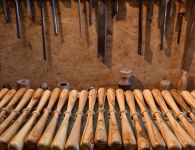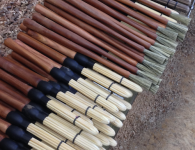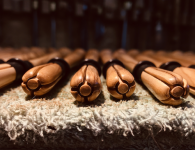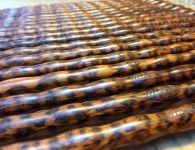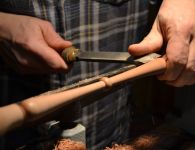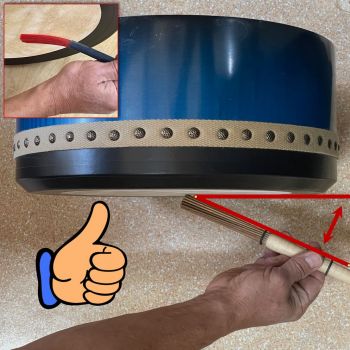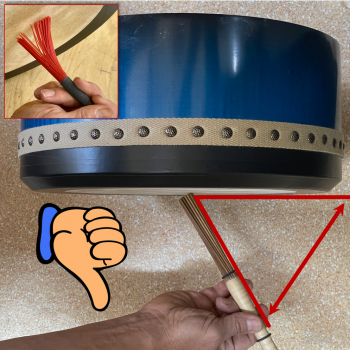Life span of bodhrán drumheads
Can tippers destroy drumheads?
Prologue
Reading about tippers online you’ll frequently come across warnings that certain tippers will inevitably destroy the skin of a drum. However, the topic - like so many others - is much more complex, and a general answer would lead to an unnecessary restriction of the sound spectrum offered by the use of different tippers.
The drum head
The range of different drumheads used for bodhráns is just as varied as the range of tippers. The initial basic question therefore is:
Which factors have an impact on the lifetime of a natural drumhead of the bodhrán?
- Age of the animal at the time of slaughter. The skin of young animals is more flexible and thinner, the skin of older animals becomes thicker and harder.
- UV radiation. Just as too much sunbathing damages human skin, direct sunlight, especially behind windowpanes, makes the skin brittle.
- Hand sweat. More than almost any other factor, the pH-value as well as the amount and the composition of the player's hand perspiration influence the break-in behavior and the development of the skin. Whether a skin becomes fluffy or sticky, greasy, rough, or brittle on the inside is significantly influenced by hand sweat and the player's pressure behavior.
- Animal species. Not only are there great differences in abrasion resistance, tear resistance, and durability between the skins of the most commonly used animal species for bodhrán skins, such as goat, deer, kangaroo, and calf, but there can also be major differences between the individual goat species depending on the way the animals were kept and the food they were fed.
- Processing of the skin during production. Even if a drum skin is not actually "tanned", the way the raw skin is processed into the finished drumhead has a great impact on the final properties and consequently also on the life of the drumhead.
- The musician's playing style. Excessive pressure with the skin hand, a steep ("scratchy") playing angle of the tipper, unnecessary damping of the drumhead with the upper body and skin hand, excessive playing on individual areas of the skin, and a generally incorrect playing technique will shorten the life of any drumhead, even a synthetic skin.
- Tipper selection. Different drumheads require the use of appropriate tippers. It’s also the player's responsibility to check the tipper heads regularly for damage. Chipping and other damage is indeed a major risk to any drum skin.
In short
Since there’s no such thing as "the best" drum skin, there’s also no such thing as "the lifetime" of a drum skin.For example, thin, flexible drumheads can sound incredibly tonal and respond very quickly to the lightest pressure from the skin hand, but they are not as abrasion-resistant and tough as thick skins from old animals, for example, which sound completely different and are usually harder to play or require a much longer break-in period.
The choice of the right drumhead can only be made by the player themself. For the inexperienced player, a universal drumhead such as the EdlauerSelect is ideal, as it is a robust, tuning-stable, and uncomplicated skin that doesn’t have a specific sound pattern but offers a broad sound spectrum. That’s why this skin is the standard skin for the CoreLine. It's a skin that you can't go wrong with and that suits all playing techniques
Experienced players will find their own preferred sound by trying out other drums and drumheads, and therewith also the drumhead that best suits their tonal sensibilities. Here, tastes clearly differ. For one person, a bassy, earthy, soft DRAGONSkin classic is the best, for another, a crisp, lively Lambeg skin or kangaroo is the optimum.
That's why the individual playing and tonal characteristics of each drumhead are more important than the resulting life span.
In short
You can basically damage the drumhead with ANY tipperIn a nutshell: When you play, this is exactly what happens: each stroke creates friction. And this friction creates wear. That is an incontrovertible fact. However, the friction doesn’t only produce wear, it also produces music. And just as the strings of string instruments wear out and have to be replaced at some point, so do the drumheads. Every drumhead. Even synthetic heads. New strings are usually very susceptible to tuning at first and need a certain break-in period until they are tuning-stable and sound properly. The same applies to drum skins.
In short, the life of a drumhead can be divided into three stages:
Break-in period - Playing time - Degradation time
Break-in period:
The drum skin stretches out, adapts to the shape of the frame, absorbs hand sweat, and is mechanically processed by tippers. A drumhead is said to be "broken in" when it’s achieved a full sound and good tuning stability. Depending on the drumhead, this can be between two weeks and two years. The regular break-in time for most drumheads is one to three months. Not only the actual playing time, but also rest periods and exposure to hand sweat are part of the break-in process. Therefore, a drumhead can only be broken in by its player.
Playing time:
During this time, the drum skin has developed its full potential, and any further tonal changes happen slowly and moderately. The duration of this stage of the skin’s life is largely influenced by the player and can be many years, even decades. However, it is possible to completely ruin a drumhead within a very short time, for example, by using damaged tippers and a wrong playing technique.
Especially if the drumhead is played in the same spot all the time, it can become very compressed, and then no longer resonates cleanly. In this case, a "skin reset" can be carried out several times in the course of the drumhead's life. By treating the drumhead with water, the skin structure loosens up again and the drumhead sounds as it should.
Basically, the main enemy of the drumhead is friction. Every measure that reduces friction prolongs the life of the drumhead. Just remember that every improvement in playing style is multiplied a million times for every single beat. Therefore, the playing time of a drumhead varies considerably from player to player.
Possibilities for the player to extend the playing time:
- A shallow playing angle of the tipper prevents scratching on the drumhead and reduces concentrated friction at the contact point. With a steep playing angle, there is a risk of the tipper/hot rod sticks "stabbing" into the skin. This inevitably leads to scratches and hairline cracks, and roughens the surface like sandpaper.
- Minimal force from the tipper hand and the skin hand. The drum must be able to swing, to work. Unnecessary damping only consumes energy and creates more pressure and friction.
- If possible, constantly turn the drum a little while playing. This distributes the hand sweat and the mechanical impact caused by the tipper more evenly and thus leads to more even playing and greater tuning stability.
- Tipper selection. See below!.
Degradation time:
The drumhead finally loses its inner tension and "vitality". Mechanical stress can cause the head to become rough, cracked and brittle, and to develop cracks or friction holes. Now the "second life" of the animal skin is over, and it can be returned to the natural cycle. Even synthetic skins will eventually be "played out" and only sound dull and flat. Now a new drumhead is needed and the cycle starts all over again.
Tipper selection – some tipper basics
From a physical point of view, the main task of the tipper is to make the skin vibrate by means of friction. In other words, it is a tool. Like any other tool, be it a blunt hammer or a sharp kitchen knife, improper use can lead to injuries for the user, or damage to the workpiece or the tool itself.
It is similar with tippers: the greater the sound possibilities, the more fragile the tipper or/and the higher the risk of injury to the drumhead.
Examples:
A solid wood tipper with a large, rounded head has a large attack surface, which means a wide distribution of pressure, and therefore minimal concentrated pressure, but a relatively muffled sound. A solid wood tipper with a small, sharp-edged head produces a precise, crisp, defined sound, but generates high pressure at the contact point with a lot of friction. A shallow playing angle helps to reduce the friction considerably while still producing optimal sound.
With click tippers, longitudinal cuts provide the characteristic “clicky” sound. To avoid damage to the drumhead, the flanks and attack surfaces of these tippers are deburred. A shallow playing angle is absolutely essential here, as a steep playing angle will damage the skin by "stabbing into it", and the flanks of the tipper may break off.
Hot rod tippers consist of many individual rods made of wood, bamboo or fiber materials. The opening angle can usually be adjusted with sliding rings. Since several impact points are created at the same time when hitting the drumhead, these tippers are very popular because of their full sound. Here, too, a shallow playing angle is appropriate, as a steep angle would produce a multiple of impact friction. A steep playing angle would act like sandpaper and roughen the drumhead.
Caution
Loose clothing, scarves, and long hair! The rods can get caught and break off. Damaged hot rods are a great danger to the drumhead and must be repaired or replaced without question!Brush tippers have animal hair, or plant or plastic fibers at the beating ends. These can do almost no damage to the drumhead, but a shallow playing angle increases the lifespan of the fibers.
Split bamboo tippers (frayed ends) have a very soft attack and are particularly suitable for soft, bass-line accompaniments because of their general “bassy” character. Due to the high amount of fiber, there is always a lot of friction. A shallow playing angle is absolutely necessary! These tippers are best suited for use on synthetic heads, which are generally more abrasion-resistant.
Bamboo is a special case
Explicit warnings about bamboo tippers appear time and again. Bamboo is not a wood in the classical sense, but a woody grass with silica deposits. These mineral deposits can indeed have razor-sharp flanks that act like sandpaper. However, expertly finished attack surfaces (through rounding and sanding) create a unique base material for tippers. The sound of bamboo hot rods is present, crisp and with a fine clicking sound. This makes bamboo hot rods a unique, incomparable sound option that you can safely use if obtained from a quality manufacturer. Again, a shallow playing angle is essential to optimize the life span of both drumhead and tipper. .Conclusion
HEDWITSCHAK DRUMS and MOISES TIPPERS have been working on the development and improvement of drumheads and tippers for many years. We see our task as creating the widest possible range of sound options and playing possibilities for the musician with our products.
It is the player's responsibility to use these products properly and to take care of them. A regular tipper check during which all attack surfaces are carefully inspected and any sharp ends that may have developed are carefully sanded should be a matter of course for every player.
This way you are guaranteed to enjoy our products for a long time!
Christian Hedwitschak, Stevie Moises und Rolf Wagels


